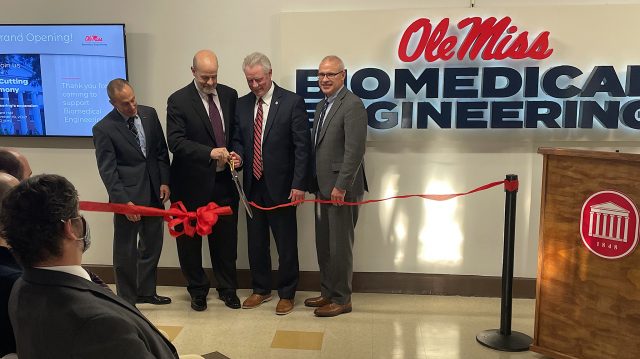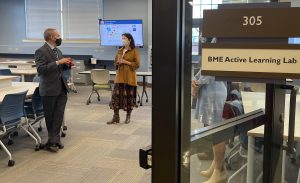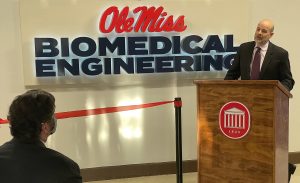
UM engineering Dean David Puleo (from left), Department of Biomedical Engineering Chair Dwight Waddell, Chancellor Glenn Boyce and Provost Noel Wilkin cut a ribbon to celebrate the opening of the new Department of Biomedical Engineering expansion in Brevard Hall. Photo by Shea Stewart/Office of Research and Sponsored Programs
OXFORD, Miss. – The University of Mississippi has unveiled its sparkling new biomedical engineering expansion that will better prepare students for careers in a pioneering field that combines technology with medicine.
The roughly 6,500-square-foot space, on the third floor of Brevard Hall, also will help nurture innovative research and advance the technological and economic development of Mississippi, the region and the nation, campus leaders said.
“We have the first Department of Biomedical Engineering in the state of Mississippi, and this program is going to grow enormously over the next several years and beyond,” Chancellor Glenn Boyce said at the Nov. 19 ceremony.
“What you see today is the beginning. What you’re going to see in five years or 10 years is going to be extraordinary. I know we’ve got the students and the graduates who are going to become exceptional in the field.
“When we start our research on medical devices and we get our own devices going, we’re going to have businesses and companies who are going to want to come see us and visit with us. That’s what we want to make sure happens for the state of Mississippi and certainly for the reputation of this program.”
Created in November 2016, the department has flourished, welcoming its inaugural class in the fall of 2017 and celebrating its first freshman-to-senior graduating class in May 2021. The program is the third-largest department in the School of Engineering, with more than 60% of its undergraduate students women and nearly half enrolled in the Sally McDonnell Barksdale Honors College.

UM engineering Dean David Puleo talks to visitors in the new Department of Biomedical Engineering expansion following a ribbon-cutting ceremony for the space. Photo by Shea Stewart/Office of Research and Sponsored Programs
About 130 students are enrolled in the program, where students choose a trck of study in biomolecular engineering, biomedical systems or bioinformatics.
Within the last year, the department’s faculty also have generated more than $1.5 million in research funding from agencies such as the National Institutes of Health, the American Heart Association and the American Cancer Society.
“Biomedical engineering and this newly renovated space are where students can get their hands on stuff,” said Dwight Waddell, associate professor and chair of biomedical engineering. “Hands-on engineering is the best dress rehearsal because much of what we ask students to do in a laboratory setting informs how and what they’re going to do for their job.”
The new space includes an active learning room, an information technology-rich environment that allows for student collaboration as they address real-world problems.
The space also includes an innovation lab and a fabrication lab, both of which include high-end industrial equipment such as computer-guided laser cutters, advanced 3D printers and a mechanical testing system that mimics loads seen in a real-time environment.
“It’s basically a machine that pulls, pushes or twists objects,” Waddell said. “In a sense, it breaks things, and it teaches young people when you build something and it’s under forces, eventually it’s going to wear and fail. This shows how and where it does, and how we can better understand the process.”
While the simple definition of biomedical engineering is technology meeting medicine, Waddell said it’s a wider and broader field than people think.
Members of the class of 2021 are pursuing careers in biomedical industries such as medical device design, biotechnology and pharmaceutical research and sales, while others have entered medical, dental, law and graduate schools to expand their knowledge and add to their Ole Miss experiences.

Dwight Waddell, associate professor and chair of biomedical engineering, speaks at the ribbon cutting for the new Department of Biomedical Engineering expansion in Brevard Hall. Photo by Shea Stewart/Office of Research and Sponsored Programs
“What we do is we create a bag of very useful tools for a young person to carry around,” Waddell said. “And at that point, they can peddle their wares wherever someone finds use for the tool.”
The new space will only increase the department’s opportunities for students and provide them with the knowledge to explore and develop their biomedical engineering interests, said David Puleo, dean of the School of Engineering and professor of biomedical engineering.
“The renovated space enables biomedical engineering students to work individually and in teams to understand and then design solutions that improve human health,” said Puleo, who recently was inducted as a fellow of the National Academy of Inventors. “The labs provide advanced instrumentation for students to learn by doing, whether making physiological measurements, developing new devices or 3D-printing implants.”
The biomedical engineering expansion is just one area where the university is pushing the boundaries of student education, faculty research and economic development, UM Provost Noel Wilkin said.
“Dr. Dwight Waddell was optimistic that he could create a program that would be in demand, attract amazing faculty, garner the support of the university and make a difference,” Wilkin said. “Dr. Waddell and Dean Puleo brought this space into focus, and with the hard work of the faculty and staff, and the partnership with the university, we are standing before it today.
“This space is a beacon of optimism, not only within the School of Engineering but across our university. It is a belief that we can make a difference, and it’ll matter to the world.”